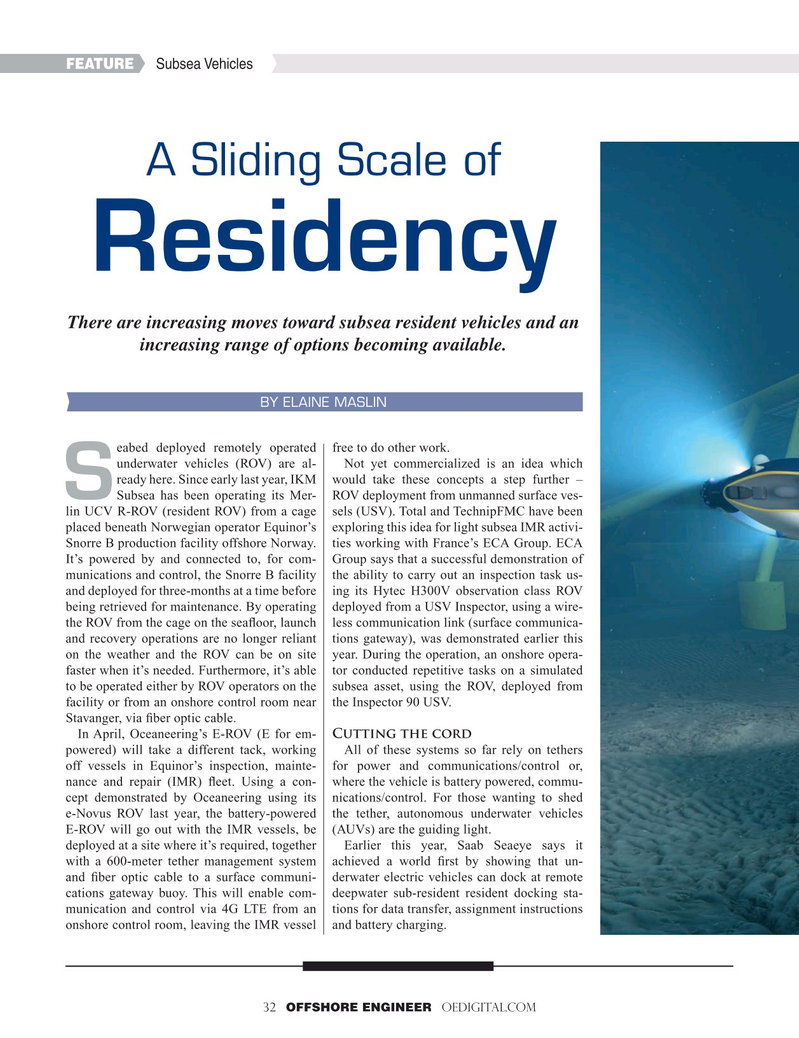
Page 32: of Offshore Engineer Magazine (Mar/Apr 2019)
Deepwater: The Big New Horizon
Read this page in Pdf, Flash or Html5 edition of Mar/Apr 2019 Offshore Engineer Magazine
FEATURE Subsea Vehicles
A Sliding Scale of
Residency
There are increasing moves toward subsea resident vehicles and an increasing range of options becoming available.
BY ELAINE MASLIN eabed deployed remotely operated free to do other work. underwater vehicles (ROV) are al- Not yet commercialized is an idea which ready here. Since early last year, IKM would take these concepts a step further –
S Subsea has been operating its Mer- ROV deployment from unmanned surface ves- lin UCV R-ROV (resident ROV) from a cage sels (USV). Total and TechnipFMC have been placed beneath Norwegian operator Equinor’s exploring this idea for light subsea IMR activi-
Snorre B production facility offshore Norway. ties working with France’s ECA Group. ECA
It’s powered by and connected to, for com- Group says that a successful demonstration of munications and control, the Snorre B facility the ability to carry out an inspection task us- and deployed for three-months at a time before ing its Hytec H300V observation class ROV being retrieved for maintenance. By operating deployed from a USV Inspector, using a wire- the ROV from the cage on the sea? oor, launch less communication link (surface communica- and recovery operations are no longer reliant tions gateway), was demonstrated earlier this on the weather and the ROV can be on site year. During the operation, an onshore opera- faster when it’s needed. Furthermore, it’s able tor conducted repetitive tasks on a simulated to be operated either by ROV operators on the subsea asset, using the ROV, deployed from facility or from an onshore control room near the Inspector 90 USV.
Stavanger, via ? ber optic cable.
In April, Oceaneering’s E-ROV (E for em- Cutting the cord powered) will take a different tack, working All of these systems so far rely on tethers off vessels in Equinor’s inspection, mainte- for power and communications/control or, nance and repair (IMR) ? eet. Using a con- where the vehicle is battery powered, commu- cept demonstrated by Oceaneering using its nications/control. For those wanting to shed e-Novus ROV last year, the battery-powered the tether, autonomous underwater vehicles
E-ROV will go out with the IMR vessels, be (AUVs) are the guiding light. deployed at a site where it’s required, together Earlier this year, Saab Seaeye says it with a 600-meter tether management system achieved a world ? rst by showing that un- and ? ber optic cable to a surface communi- derwater electric vehicles can dock at remote cations gateway buoy. This will enable com- deepwater sub-resident resident docking sta- munication and control via 4G LTE from an tions for data transfer, assignment instructions onshore control room, leaving the IMR vessel and battery charging.
32 OFFSHORE ENGINEER OEDIGITAL.COM 32-49 OE 2019.indd 32 4/15/2019 3:45:14 PM

 31
31

 33
33